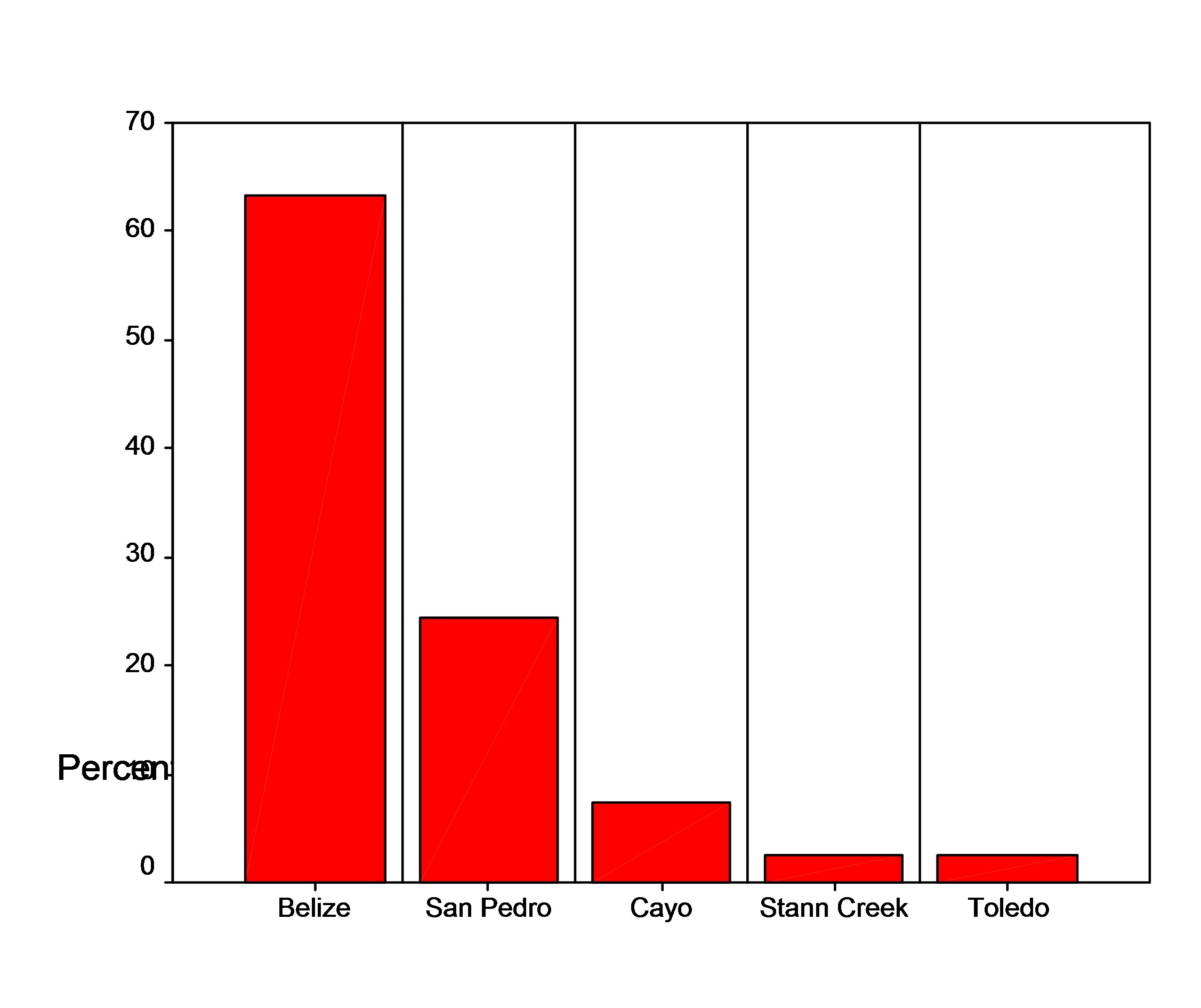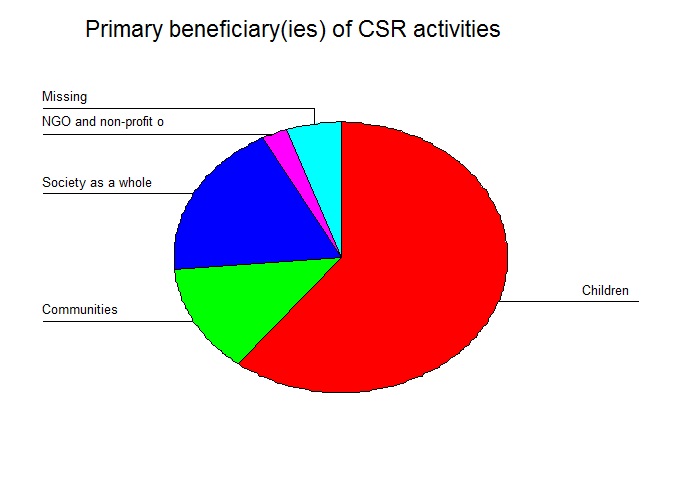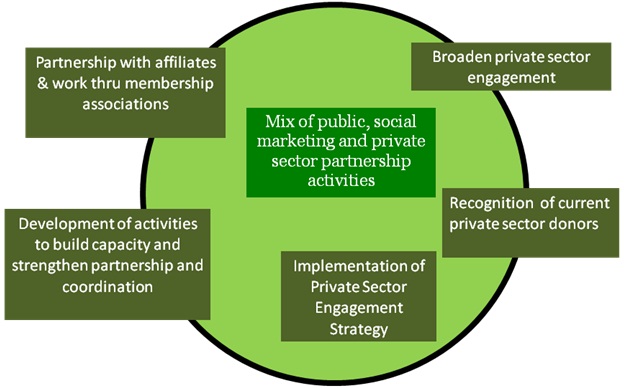Figure 1.1

A key ingredient to engage the private sector in the country's development debate is the practice of Corporate Social Responsibility (CSR). Corporate Social Responsibility can be defined as a commitment to improve the community's well-being through discretionary business practices and contributions of company resources (Kotler & Lee, 2008). Corporate Social Responsibility has been gaining momentum and private sector engagement is at the helm. Amidst the challenge of developing a mutual beneficial relationship between the local community and private sector entities, there is a need for greater Government involvement. The conventional approach to corporate social responsibility used to be simply "Fulfilling an Obligation". This traditional approach versus the new strategic approach to corporate philanthropy seeks to balance contribution with the concept of the greater good. Similarly, private sector resources and contributions have been stimulating our Belizean society and has been a major driving force in the development of our economy. In order for us to sustain and strengthen such innate corporate social responsibility there must be a strong Government of Belize involvement in the relationship.
No corporate entity can afford to be totally oblivious to the needs of a community of which it is a part. In fact, there is an ongoing global market pressure for companies to promote Corporate Social Responsibility.
Organizations can be characterized as a private sector entity based on the nature of their ownership. Private sector organizations are not owned or supported by the government. Instead, private sector organizations are under private rather than government control.
For purpose of this report, private sector entities were grouped into three distinct categories:
The study utilized an abridged version of the 2006 Society for Human Resource Managers (SHRM) survey. The survey instrument had a total of 15 questions: 7 close-ended questions; 7 mixed questions (closed-ended with an opportunity for open-ended response) and finally, one open-ended question (Appendix).
Capitalizing on the Belize Chamber of Commerce's Membership Listing and Belize Red Cross' Mailing Listing, a list of 270 countrywide organizations was developed. A sample of 100 of these entities was randomly selected to participate in the study. Each organization was sent an email requesting participation by completing and returning the survey. The survey was fielded for a period of four weeks, followed by email reminders to increase the response rate. The email reminders were later followed-up with a call.
Later, HR professionals within the selected companies were contacted via telephone to remind them of the surveys sent by email. In some cases, the HR Professionals agreed to complete the survey by a telephone conference.
As previously mentioned, from a population of approximately 270 entities, a sample size of 152 was selected using Krejcie & Morgan (1970) Guidelines for Selecting representative Samples and Israel (2007) Determining Sample Size. This included an additional 30% to compensate for non-responses. For the survey of countrywide corporate entities in Belize, 41 responses were received garnering a 27% response rate.
To avoid duplication of results, both mailing lists were merged and all duplicates eliminated. The corporations selected were isolated based on the representation of the business density according to each district. The Chamber of Commerce listing had a relatively representative sample as it incorporated companies from across the country and The Cayes. However, it was noted that Orange Walk had its own Chamber of Commerce, so there was a limitation in terms of representation for this district. Notably, most of the companies had business locations in several districts. In this event, the district office contacted was reflected in the survey as opposed to their main office. The gap identified in the use of the Chamber of Commerce's listing was filled by the incorporation of the Belize Red Cross listing.
The companies were later categorized on the basis of distinct characteristics. The companies were grouped into one of the three categories: Small to Medium Enterprise (SMEs) - had 5 to 15 employees; Medium to Large Enterprise (MLEs) - had 16 to 50 employees; or Large Enterprise - over 50 employees. There were 8 SMEs, 14 MLEs and 19 large enterprises as per Figure 1.1 below. MLEs and large enterprises were significantly represented in this survey. Overall, representation of all three categories of companies was well represented in the study.
As with any research, it is necessary to note that the results are truly representative of the sample of corporate entities who responded to the survey. Based on the response rate, the results have been published with 95% confidence level and a 5% margin of error. This confidence level and margin of error should give some measure of how much one can rely on the results of this survey or survey responses to represent total number of corporate entities in Belize.
The response rate was rather low and a stratified random sampling would have assisted in isolating the various categories of business type. The sample population did not view the survey as urgent and as such this affected the response rate. Based on further discussion with key stakeholders, there were some recommended changes to the survey instrument. A revised version has now been appended (See Appendix II) to assist if a future study of this nature is conducted. This study can be viewed as a baseline study as no previous study of this nature had been conducted prior to this.
As per Figure 1.1 below, a total of 41 entities participated in the survey: 26 (63.4%) entities from Belize, 10 (27.4%) entities from San Pedro, 3 (7.4%) entities from Cayo and 1 (2.4%) each from Toledo and Stann Creek respectively. Every company that participated in the survey reported that their company participated in the community through corporate social responsibility, whether through formal or informal policies that was existent in their firms.
Figure 1.1

Based on the responses, companies that reported that their anticipated benefits were "improved perception about company" and "goodwill" also reported that the main positive outcomes to their organization based on CSR programs was: stronger public image and improved employee morale.
The largest percentage of corporate entities reported that their companies donated to Education, followed closely by the areas of HIV/AIDS and Health. Primary beneficiaries of CSR programs were children, followed by the society as a whole. Companies that participated in CSR programs demonstrated or documented their commitment to such practices to their stakeholders primarily with the use of a report (newspaper, radio, TV ad) dedicated exclusively to CSR.


The most commonly selected response when asked what the perceived role of Government in Corporate Social Responsibility was to promote partnership on interventions. The largest percentage of companies reported that funds were allocated for CSR and that their organization's donation cycle was mostly annually or monthly. Most of these organizations indicated that they do not calculate their return on investment for CSR programs or contributions. With that noted, the largest percentage of organizations also indicated that their form of contribution was in both cash and in kind. The level of support of corporate social responsibility practices ranged from medium to high. Most organizations reported that they would be willing to team up with other organizations in CSR efforts.

Based on the results of the survey, private sector participation can be described as ranging between high and medium. It is evident, however, that most of these private sector initiatives are clearly linked to some kind of intangible benefits to the contributing organization. The efforts are subjective as there is no mandate or regulating agency that influences contribution. In general, participation is dictated by the type of industry the business is in or the primary drivers of that company. In any event, organizations willingness to provide written or visible publications of their commitment to corporate social responsibility underlines the cross-cutting theme of transparency in the way business is conducted. On average, companies willingly participated in corporate social responsibility programs without coercion and did not feel the need to calculate their returns on such investments.


Whilst companies are willing to play a participatory role, they appeared isolated in coordinating and implementing these efforts. However, they expressed interest in directing their efforts to an organization that was willing to spearhead and organize such efforts.
It is essentially important to foster a mutually supportive partnership with corporate entities in close-knit communities. Most of today's organizations capitalize on the human resources from these very same close-knit communities. It is evident that business who benefit from society will eventually need to come up with revolutionary ways to give back to that community. Based on the comprehensive study conducted the following recommendations are provided:

The proposed private sector engagement strategy will enable an NGO to benefit from a plethora of private sector entities involved in community development issues that are closely related to the NGO's objectives. This challenge will require innovative and flexible approaches to facilitate and sustain medium and long-term partnerships between NGO's and the private sector. Each partnership will have its own legal and financial frameworks.
In closing, the ability for an NGO to influence private sector will eventually dictate where funds will be allocated and what programs will be funded. Even though the study reported that organizations do not calculate return on investment, it will become increasingly important for corporation to take greater account and assess the results of their corporate social responsibility. The greater the influence of the NGO; the greater the number of possibilities for companies to become more involved in CSR initiatives.
Balboni, Fabio (2007). "Possible Strategies to Enhance the Effectiveness of CSR in Trinidad and Tobago: The Role of Public Agencies", UNDP T&T.
"Convention on the Rights of the Child". (1999). Adopted by the General Assembly of the United Nations.
Longuet, Helene. (2001). Marketing Philanthropy for Teens.
National Committee for Families & Children. "National Plan of Action." Marketing Knowledge Center.
Power point presentation: "The role of CSR in the achievement of the MDGs and the goals stated in Vision 20/20".
SCN 2004. "SCN Private Sector Engagement Report." Geneva: SCN.
Fox, Tom; Ward, Halina & Howard, Bruce. (2002). "Corporate Social Responsibility Practice. Public Sector Roles in Strengthening Corporate Social Responsibility: A Baseline Study." The World Bank. Corporate Responsibility for Environment and Development Programme International Institute for Environment and Development (IIED).
UNICEF. (2009). "Global Corporate Alliance Fundraising Strategy."
UNICEF. (2008). "Intercountry programs: Country Program Recommendation." Document Repository.
UNICEF. (2007). "Mexico: Draft Country Program." Document Repository.
UNICEF. (1999). "Recommendation for Funding for a Short-Duration Country Programme - Botswana." Document Repository.
HTML last revised 4th December, 2011.
Return to Conference papers.